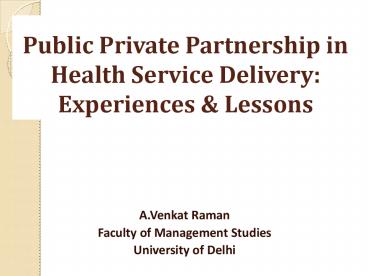Public Private Partnership in Health Service - PowerPoint PPT Presentation
1 / 46
Title:
Public Private Partnership in Health Service
Description:
Public Private Partnership in Health Service Delivery: Experiences & Lessons A.Venkat Raman Faculty of Management Studies University of Delhi ... – PowerPoint PPT presentation
Number of Views:116
Avg rating:3.0/5.0
Title: Public Private Partnership in Health Service
1
Public Private Partnership in Health Service
Delivery Experiences Lessons
- A.Venkat Raman
- Faculty of Management Studies
- University of Delhi
2
WHY PARTNER WITH THE PRIVATE SECTOR?
3
Omnipresence of the Private Sector
- 93 of all hospitals
- 64 of all beds
- 80 doctors
- 80 of OP and
- 57 of IP .are in the Pvt. Sector
- (World Bank 2001)
- Estimated at Rs. 1,56,000 Cr. in 2012 Rs.
39,000Cr.. for health insurance (NCMH 2005)
4
Share of Pvt. Sector- Non- Hospitalized care
(60th NSS-2004)
5
Share of Pvt. Sector- Hospitalized care (60th
NSS-2004)
6
Share of Private Sector in Rural Areas
(NCMH,2005)
7
Relative expenditure in the private sector - in
Rural Areas (NCMH,2005)
8
Who Pays for the Services?Percentage of Private
Expenditure (NHA-2004-05)
9
Implications
- gt80 of health expenditure is out-of-pocket.
(NSS 2005 NHA,2004-05) - Debilitating Effects on the poor Liquidation of
assets, indebtedness. 40 of hospitalized 2 in
the country every year end up BPL - (World Bank, 2001).
- Compounded by poor regulation of private sector
10
Private sector is needed because....
- India needs an additional
- 750,000 beds
- 520,000 doctors
- overall investment of Rs 1,50,000Cr.
- 80 likely to come from the private sector
(NMCH,2005)
11
PPP MODELS TYPES
12
- Not all interactions between the Government and
Private sector are PPPs
13
Financing vs DeliveryPublic vs Private modes
(Bloom, 2001)
14
Common PPP Models
- Contracting (in and out)
- Joint Ventures
- Build/ Rehabilitate, Operate, Transfer
- Health Financing (Vouchers, CBHI, Illness fund)
- Mobile Health Units
- Franchising
- Social Marketing
- Technology demos (e.g. Telemedicine)
- Public-Private Mix
15
Core Principles of Partnership
- True partnerships entail
- Relative Equality between partners
- Mutual Commitment to Public Health objectives
- Benefits for the Stakeholders
- Autonomy for each partner
- Shared decision-making and accountability
- Equitable Returns / Outcomes
16
PPP Models in Practice
17
(No Transcript)
18
(No Transcript)
19
(No Transcript)
20
(No Transcript)
21
(No Transcript)
22
(No Transcript)
23
(No Transcript)
24
(No Transcript)
25
(No Transcript)
26
(No Transcript)
27
(No Transcript)
28
OTHER MODELS IN OPERATION
29
(No Transcript)
30
(No Transcript)
31
(No Transcript)
32
EMERGING MODELS
- Regional Diagnostic Centres- Hub/Spoke
- Medicity
- Co-location of Specialty services
- District Hospital Medical College (Hub)
- Franchised /Accredited Health Units
- RBF Incentive Contracts
33
Key Lessons Challenges in PPP Indian
Experience
34
Political and Administrative Commitment
- Half hearted support for PPP
- Top officials are enthusiastic, but success takes
them away- leadership vacuum - Lower level officials suspect PPP as
privatization or show disdain towards the
private provider
35
Institutional Capacity
- Need for technical / managerial skills for
designing, negotiating, implementing and
monitoring PPP contracts - Develop institutional capacity at all levels,
including oversight role.
36
Policy and Institutional Framework
- Lack of policy driven strategy towards PPP in
health sector. Need for a PPP policy. - Lack of information on Private sector thus poor
regulatory leverage. - No institutional structures to manage PPP
contracts. Need for specialized PPP cell in
Health Dept.
37
Social Context of PPP
- Antipathy or suspicion towards the private sector
and govts failure to regulate -raise suspicion. - Unwillingness of civil society organisations to
explore PPP as an option. - Squeamishness about profit making in services
meant for poor patients
38
Diversity and Complexity of Private Sector
- Private sector is diverse Predominantly
individuals (owner operated units) and from both
recognized and unrecognized systems of medicine - Diversity of tariffs, thus complicating
information on cost vs tariff and tariff
negotiations
39
Process of Contracting Partner selection
- Primarily input based contracting rather than
outcome based. - (Only) competitively selected partners are less
effective. - Priorities of
- Govt. Officials Compulsion of L1 Completing
procedural formalities. - Private Sector Winning the bid by all means
40
Risk
- Financial risk to the private partner- Non-timely
release of funds Fear of enquiry. - Risk of unsuccessful/ failed contract leading to
lack of services patinets suffer, resources
wasted.
41
Enabling conditions for success
- Successful partnerships are contextual. Enabling
conditions include - leadership from both partners
- prior consultation
- relational / trust based contracting
- pilot testing,
- timely payment
- periodic review and amendments / revision of
contract - specific performance indicators..
42
Key Constraints
- Payment delays
- Personality styles and trust level
- Local political interference / political
flip-flaps - Non-revision of contract clauses (Tariffs)
- Lack of capacity or willingness to supervise /
monitor / guide the project - Perceptual and attitudinal orientation to private
sector - Lack of clarity of the objective of PPP
43
Limitations in Contract Features
- Defining and verifying beneficiaries (BPL
patients)- especially high cost services - Defining Quality or Performance or Outcome
indicators - Supervision and Monitoring mechanism
- Timely revisions / updating of contract
- Ombudsman for dispute settlement
- Clarity on user fee
44
Summary
- Public-private partnership (PPP) is not
privatization - Government continues to play a key role
- Requires high degree of institutional capacity
45
In conclusion.Public Private Partnership
- does help benefiting the poor.
- one of the pragmatic options for health
service delivery, but not an alternative to
public delivery or better governance.
46
THANK YOU
- Ref. Book
- A.Venkat Raman J.W.Bjorkman
- Public Private Partnership in Health Care in
India Lessons for Developing Countries.
Routledge, London, 2009 - http//south.du.ac.in/fms/idpad/idpad.html































